Direct View of Phonon Dynamics in Atomically Thin MoS2
Transition-metal dichalcogenide monolayers and heterostructures are highly tunable material systems that provide excellent models for physical phenomena at the two-dimensional limit. While most studies to date have focused on electrons and electron–hole pairs, phonons also play essential roles. Here, we apply ultrafast electron diffraction and diffuse scattering to directly quantify, with time and momentum resolution, electron–phonon coupling in monolayer molybdenum disulfide and phonon transport from the monolayer to a silicon nitride substrate. Optically generated hot carriers result in a profoundly anisotropic distribution of phonons in the monolayer within ∼5 ps. A quantitative comparison with ab initio ultrafast dynamics simulations reveals the essential role of dielectric screening in weakening electron–phonon coupling. Thermal transport from the monolayer to the substrate occurs with the phonon system far from equilibrium. While screening in two dimensions is known to strongly affect equilibrium properties, our findings extend this understanding to the dynamic regime.
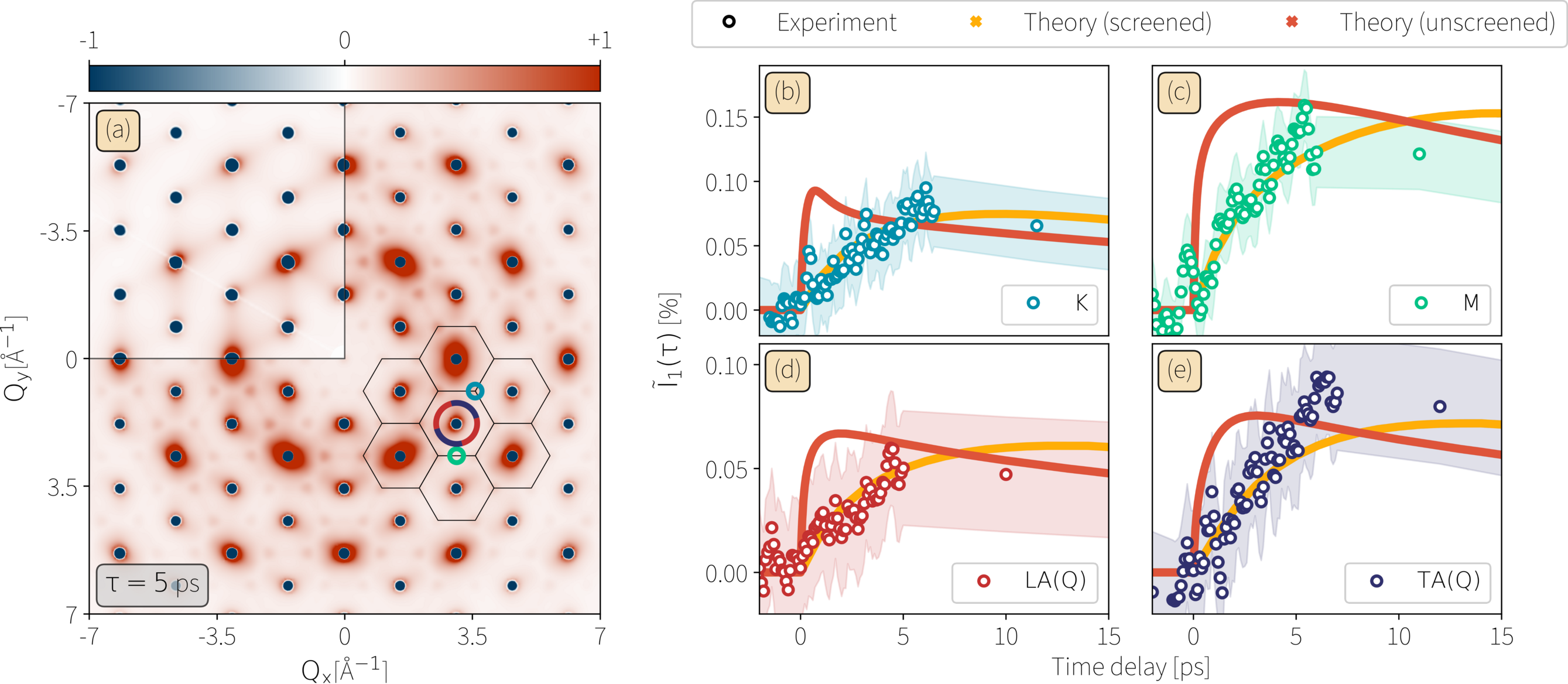
“The ability to directly visualize atomic motion throughout the material when the atoms have arbitrary momentum, or its classical analog speed, has been lacking historically and is critical to understanding how these materials behave.” @_trbritt @McGillUPhysics @McGillChemistry
— McGill Science (@McGillScience) June 20, 2022
- T. L. Britt, Q. Li, L. P. René de Cotret, N. Olsen, M. Otto, S. A. Hassan, M. Zacharias, F. Caruso, X. Zhu and B. J. Siwick, Direct view of phonon dynamics in atomically thin MoS2, Nano Lett. 22 (2022) DOI: 10.1021/acs.nanolett.2c00850
Observing the ultrafast formation of polarons in the high-performance thermoelectric SnSe
SnSe is one of the highest-performing bulk thermoelectric materials, with a record-breaking ability to generate electricity from heat. In this work, we photodope the material to doping levels required for efficient thermoelectric device operation (up to ~1021 cm-3), and follow the relaxation of the system on ultrafast timescales (<150 fs) using ultrafast electron diffraction and diffuse scattering simultaneously.
We directly visualize the formation of polaron quasiparticles as the photo-doped carriers become dressed by phonons following photoexcitation. Two modes of polaronic distortion are observed on separate timescales. Large quasi-one-dimensional polarons are formed on the 300 fs timescale, with smaller isotropic polarons forming at least 10x slower. This bimodal polaron formation is understood in the context of profoundly anisotropic electron-phonon coupling, with strong Frölich coupling only to certain zone-center polar phonon modes. This research shows how important strong electron-phonon coupling is to the understanding of high-performance bulk thermoelectrics.
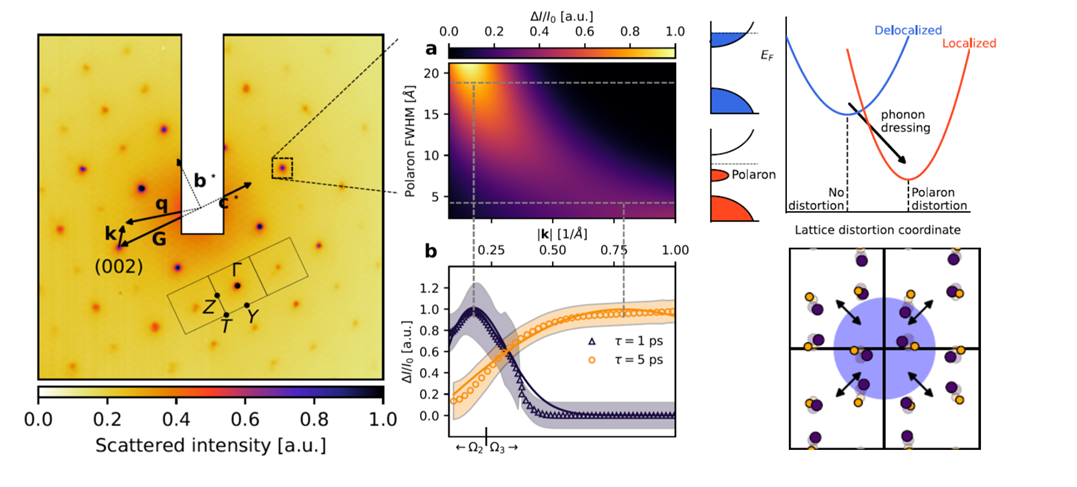
McGill University News
- L. P. René de Cotret, M. R. Otto, J.-H. Pöhls, Z. Luo, M. G. Kanatzidis, and B. J. Siwick, Direct visualization of polaron formation in the thermoelectric SnSe, PNAS 119 (2022) DOI: 10.1073/pnas.2113967119
Probing the electronic susceptibility of an excitonic insulator
In this work, we show that ultrafast electron diffuse scattering measurements of phonon hardening are a sensitive measure of the wavevector-dependent electronic susceptibility \(\chi(\mathbf{q})\) of charge-density wave material TiSe2: \[ \omega^2(\mathbf{q}) = \omega_0^2(\mathbf{q}) - \omega_0(\mathbf{q}) \chi(\mathbf{q}) / \hbar \] where \(\omega_0(\mathbf{q})\) is the bare vibrational frequency in the absence of coupling. Our measurements reveal a relatively isotropic electron-phonon coupling vertex, implying that local interactions are dominant. Moreover, the critical soft transverse optical phonon is strongly renormalized by the charge-carrier density and explains the temperature-dependence of the softening at equilibrium.
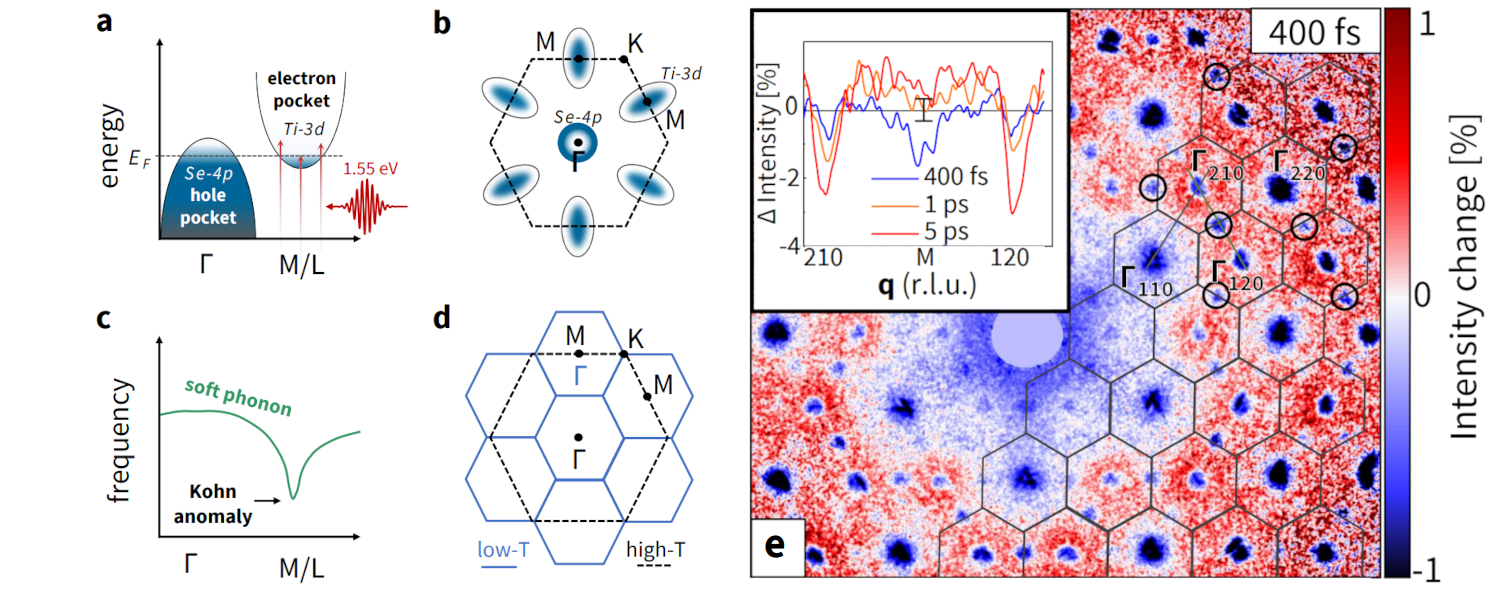
- M. R. Otto, J.-H. Pöhls, L. P. René de Cotret, M. J. Stern, M. Sutton, and B. J. Siwick, Mechanisms of electron-phonon coupling unraveled in momentum and time: The case of soft-phonons in TiSe2, Science Advances 7 (2021) DOI: 10.1126/sciadv.abf2810
Time- and momentum-resolved phonon spectroscopy
In this work we provide a description of the signals contained in ultrafast electron diffuse scattering (UEDS) measurements and a comprehensive and broadly applicable computational method for UEDS data reduction based on density functional perturbation theory (DFPT). Specifically, we present a procedure to recover phonon population dynamics as a function of the phonon branch and wavevector, and a determination of wavevector-dependent (or mode-projected) electron-phonon coupling constants from those phonon population measurements. The application of this approach to the case of photodoped carriers in the Dirac cones of thin graphite is demonstrated. The electron-phonon coupling strength to the strongly-coupled \(A_1'\) phonon at the K-point of the Brillouin zone, and the nonequilibrium optical and acoustic phonon branch populations as a function of time following excitation across the whole Brillouin zone are all determined from the UEDS measurements.
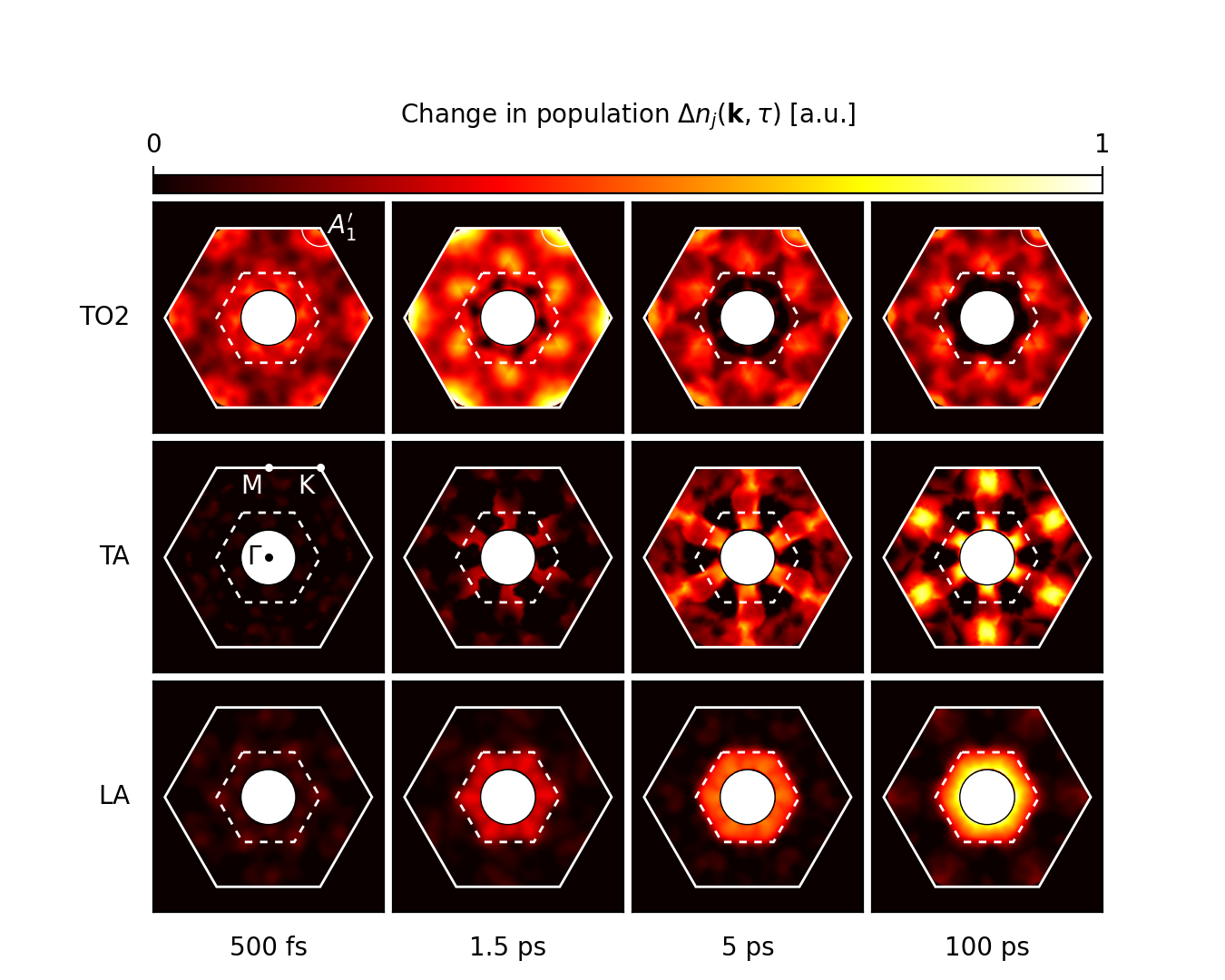
- L. P. René de Cotret, J.-H. Pöhls, M. J. Stern, M. R. Otto, M. Sutton, and B. J. Siwick, Time- and momentum-resolved phonon population dynamics with ultrafast electron diffuse scattering, Phys. Rev. B 100 (2019) DOI: 10.1103/PhysRevB.100.214115.
Non-equilibrium phases in photo-excited VO2
At excitation density values lower than that required to initiate the monoclinic to rutile phase transition, vanadium dioxide undergoes a reorganization of unit cell charge which stabilizes a meta-stable metallic phase. This monoclinic metallic phase of vanadium dioxide is depicted in the figure below showing a slice of a Fourier re-constructed volume. The phase demonstrates a charge modulation along the rutile c axis occurring on the Oxygen atoms closest to Vanadium atoms and the fluence dependence of the phase formation time suggests that the rate is governed by the energy deposited into the election system through and activated kinetic process.
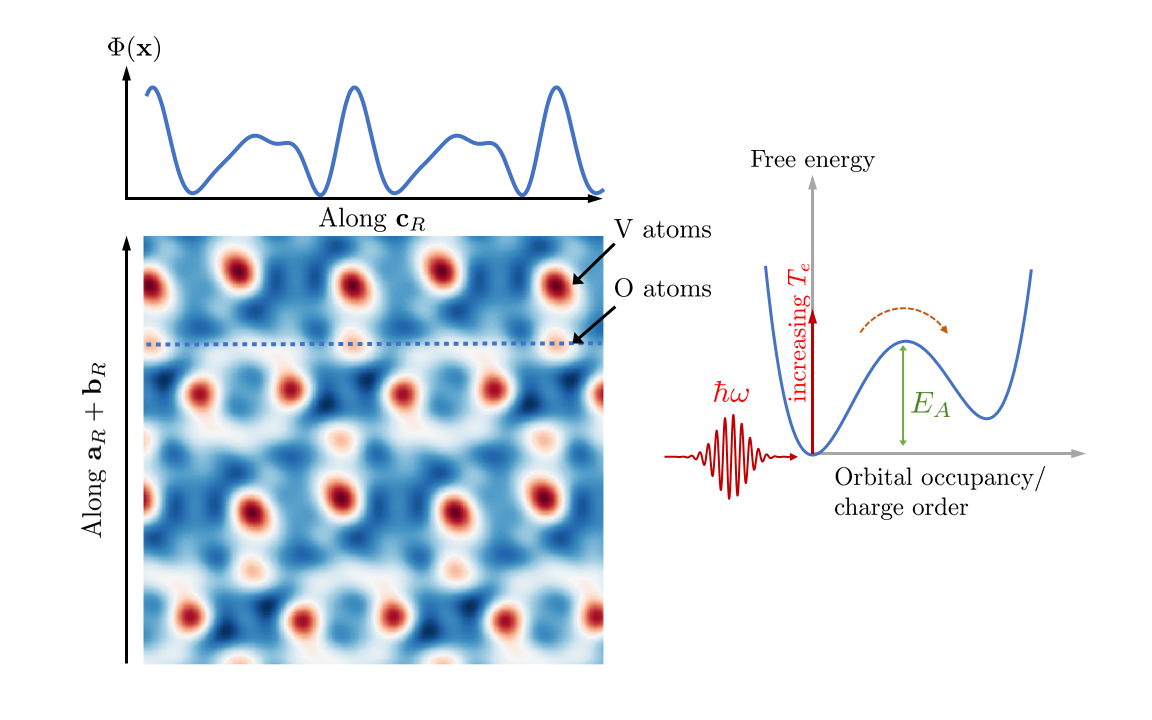
- M. R. Otto, L. P. René de Cotret, D. A. Valverde-Chavez, K. L. Tiwari, N. Émond, M. Chaker, D. G. Cooke, and B. J. Siwick, How optical excitation controls the structure and properties of vanadium dioxide, PNAS 116 issue 2, pp. 450-455 DOI: 10.1073/pnas.1808414115.
Non-equilibrium phonon dynamics with ultrafast electron diffuse scattering
Despite their fundamental role in determining material properties, detailed momentum-dependent information on the strength of electron-phonon and phonon-phonon coupling has proved difficult to obtain. Ultrafast electron diffuse scattering provides the answers.
By exploiting symmetry-based selection rules and time-resolution, scattering from different phonon branches can be distinguished even without energy resolution. Using graphite as a model system, we show that ultrafast electron diffuse scattering (UEDS) patterns map the relative electron-phonon coupling (EPC) and phonon-phonon coupling (PPC) strength through their profound sensitivity to photoinduced changes in phonon populations. We measure strong EPC to the \(K\)-point transverse optical phonon of \(A_1′\) symmetry and along the entire longitudinal optical branch between \(\Gamma\)-\(K\), not only to the \(\Gamma\)-\(E_{2g}\) phonon as previously emphasized. We also determine that the subsequent phonon relaxation pathway involves three stages; decay via several identifiable channels to transverse acoustic (TA) and longitudinal acoustic (LA) phonons (1-2 ps), intraband thermalization of the non-equilibrium TA/LA phonon populations (30-40 ps) and interband relaxation of the LA/TA modes (115 ps). Combining UEDS with ultrafast angle-resolved photoelectron spectroscopy will yield a complete picture of the dynamics within and between electron and phonon subsystems, helping to unravel complex phases in which the intertwined nature of these systems have a strong influence on emergent properties[1].
![Ultrafast electron diffuse scattering of photoexcited graphite normalized by q2. a Raw diffraction pattern of graphite. b Average relative change for diffraction patterns before photoexcitation, showing noise floor. c - f Relative changes in diffraction pattern shows changes in both elastic scattering (negative-going peaks) previously addressed in [2], and diffuse (inelastic) scattering.](./images/research/ueds_website_normalized.png)
APS Physics Viewpoint: Electrons Film Phonon Dynamics in Full
- M. J. Stern*, L. P. René de Cotret*, M. R. Otto, R. P. Chatelain, J. P. Boisvert, M. Sutton, and B. J. Siwick, Mapping momentum-dependent electron-phonon coupling and non-equilibrium phonon dynamics with ultrafast electron diffuse scattering (2018) DOI: 10.1103/PhysRevB.97.165416.
- R. P. Chatelain, V. Morrison, Bart L. M. Klarenaar and B. J. Siwick, Coherent and Incoherent Electron-phonon Coupling in Graphite Observed with Radio-frequency Compressed Ultrafast Electron Diffraction, Phys. Rev. Lett. 113 (2014) 235502.
Strongly-correlated materials physics: photoinduced phase transitions in VO2
At 67°C the conductivity of vanadium dioxide exhibits a discontinuous jump of as much as 5 orders of magnitude between the lower temperature semiconducting and the higher temperature metallic phases.
The microscopic mechanism for this metal-insulator transition (MIT) in VO2 has been the subject of profound controversy, and our understanding of the structural and electronic peculiarities of the metallic and insulating phases in VO2 is profoundly incomplete despite decades of work. The long-standing challenge to understanding the MIT has been to determine the relative role of electron-lattice interactions (lattice and charge order) and electron-electron interactions (dynamical correlations and orbital selection) to the change in properties and the nature of the low temperature semiconducting phase. In this respect the MIT in VO2 forms a benchmark problem in condensed matter physics, since it requires parsing the roles of competing/collaborating instabilities that conspire to determine the emergent properties of a material.
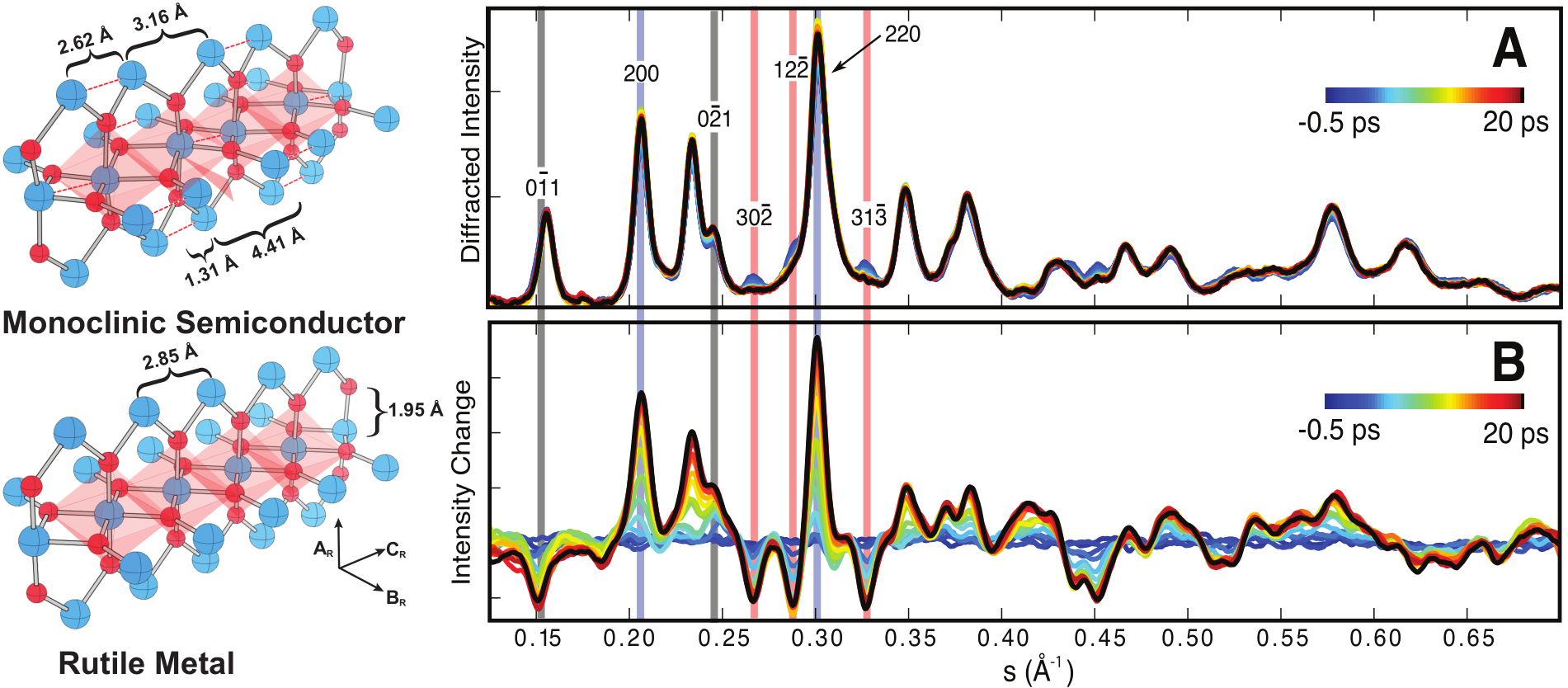
By combining the group’s dynamic materials characterization methods (RF-compressed UED and broadband mid-IR reflectivity) we recently uncovered hidden connections between electronic properties and structural degrees of freedom along the optically-induced non-equilibrium pathway between phases in VO2[1]. The combined approach made it possible to map the reorganization of the VO2 unit cell during the optically induced transition while simultaneously determining electronic properties. The results demonstrated - at low excitation fluence - a photoinduced phase transition to a long-lived state with metal-like mid-IR optical properties, but the lattice/charge-order of the semiconducting M1 phase intact. This metastable state differs from the equilibrium rutile metal crystallographically and in that it only involves a 1D reorganization of charge density rather than a transition to the isotropic 3D electronic state of the high temperature phase. The dramatic separation of the insulator-to-metal transition from the structural phase trasition that is coincident when the process is thermally activated was unexpected, and is a clear indication that the low-temperature semiconducting phase of VO2 cannot be understood by conventional band theory (electron-lattice interactions alone). The gigantic photoresponse in the mid-IR is also clear evidence that electronic correlations determine the properties of the semiconducting phases, and is a phenomena that is intriguing for applications.
This work demonstrates that UED can provide deep insights into the nature of strongly correlated materials through the disparate responses of active degrees of freedom in the time domain. Further, UED can be used to study the interplay between valence charge and lattice structure in molecular and materials chemistry. The ability to separate photoinduced changes to lattice structure and charge density is a new capability that the group seeks to explore further.
McGill Newsroom: Watching the Hidden Life of Materials
Chemical Institute of Canada: Unraveling the Atomic Puzzle of VO2
- V. Morrison, R. P. Chatelain, K. Tiwari, A. Hendaoui, A. Bruhács, M. Chaker and B. J. Siwick, A Photoinduced Metal-like Phase of Monoclinic Vanadium Dioxide Revealed by Ultrafast Electron Diffraction, Science 346 (2014) pp. 445-448. DOI: 10.1126/science.1253779.
Coherent and incoherent electron-phonon coupling in graphite
The unique electronic properties of graphite, graphene, and carbon nanotubes have inspired a great deal of attention for both fundamental and practical reasons, with the hope that these materials will enable high performance carbon based electronic devices.
In graphite and graphene, these properties emerge from the nature of the electron-lattice interactions in the highly anisotropic crystal structure; strong, covalently bound hexagonal sheets of carbon atoms (graphene) that are each weakly bound together to form the layered structure of graphite. The Siwick group has employed Radio-frequency compressed ultrafast electron diffraction to interrogate the nature of the electron-lattice interactions in graphite directly from the perspective of the lattice degrees of freedom.
Specifically, we probed the coherent and incoherent coupling of impulsive electronic excitation at 1.55 eV (800 nm) to optical and acoustic phonon modes in single-crystal graphite samples using time-resolved electron crystallography[1]. These experiments yielded rich data sets exhibiting Bragg peak intensity suppression, intensity modulation, spot position modulation and spot position shifts that were characteristic of particular lattice excitations.
A biexponential suppression of diffracted intensity due to relaxation of the electronic system into incoherent phonons is observed through the Debye-Waller effect, with the 250 fs fast contribution dominated by coupling to the E2g2 optical phonon mode at the Γ point and A01 optical phonon mode at the K point. Both modes have Kohn anomalies at these points in the Brillouin zone. The result is a unique non-equilibrium state with the electron subsystem in thermal equilibrium with only a very small subset of the lattice degrees of freedom within 500 fs following photoexcitation. This state relaxes through further electron-phonon and phonon-phonon pathways. In addition, electronic excitation leads to both in-plane and out-of-plane coherent lattice responses in graphite whose character we are able to fully determine. The in-plane motion is specifically a Γ point shearing mode of the graphene planes and the out-of-plane motion an acoustic breathing mode response of the very thin (<100 nm) crystal.
These results demonstrate that we can precisely identify lattice responses following photoexcitation in k,ω space, and that this can be accomplished with great sensitivity. The observed inter-layer shear amplitude is approximately 70 times the radius of a proton! More generally, these results highlight the enhanced time resolution and sensitivity provided by RF compressed UED and its ability to probe the fastest and most fundamental structural dynamics in material systems.
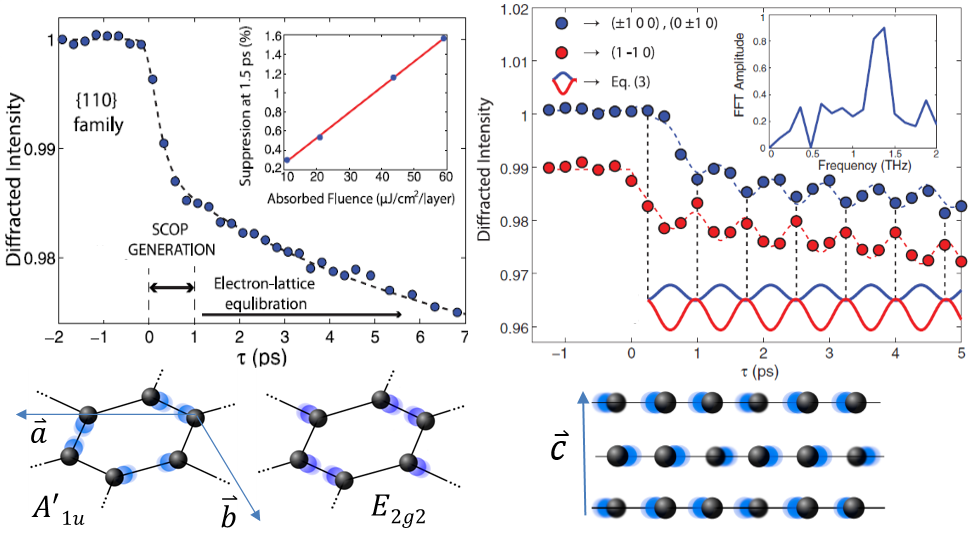
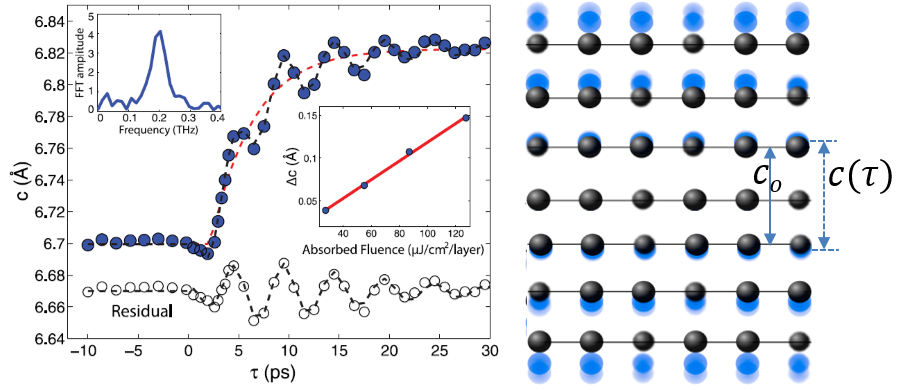
APS Physics Synopsis: Watching Electrons Shake Down a Lattice
- R. P. Chatelain, V. Morrison, Bart L. M. Klarenaar and B. J. Siwick, Coherent and Incoherent Electron-phonon Coupling in Graphite Observed with Radio-frequency Compressed Ultrafast Electron Diffraction, Phys. Rev. Lett. 113 (2014) 235502.
Dynamic transmission electron microscopy of explosive crystallization in amorphous germanium
Crystallization of amorphous germanium (a-Ge) initiated by laser or electron beam heating is a remarkably complex and technologically relevant process that involves several distinct modes of crystal growth and the development of intricate microstructural patterns on ns-to-μs time scales.
The Siwick group and collaborators at Lawrence Livermore National Lab and INRS-EMT (Quebec) have used dynamic transmission electron microscopy (DTEM) to study the fast, complex crystallization dynamics with 10 nm spatial and 15 ns temporal resolution, sufficient to follow the microstructural evolution in great detail[1]. With the unprecedented spatio-temporal resolution provided by DTEM, we have obtained time-resolved real-space images of nanosecond laser-induced crystallization in a-Ge. We were able to watch the process of nanocrystallization (nucleation and growth) in the laser-illuminated region (Zone I) as it occurs over the first ~300 ns, and directly visualize the subsequent evolution of the explosive crystallization front that propagates radially outwards from this region at speeds of up to ~16 m/s (Zone II). These images enabled the experimental determination of the complete interface response function for explosive crystallization in aGe.
This radial growth is followed by an abrupt transition to a qualitatively distinct ledge-like growth mechanism that produces a layered microstructure (Zone III) on a time scale of several microseconds. The crystallization in this region actually proceeds azimuthally, not radially, with the layered structure forming in a zig-zag manner through the interleaving of the azimuthally grown layers. This growth mode was completely unexpected and not in keeping with earlier suggestions.
These studies provided essential insights into the mechanisms governing this complex crystallization, providing a new view of the underlying processes and mechanisms. Most of the crystallization dynamics are driven by the exothermic nature of the crystallization itself (the laser only initiates the transformation) and emerges through the subtle interplay of kinetics and thermodynamics. Overall, the work is a dramatic demonstration of the power of DTEM for studying time-dependent material processes far from equilibrium.
- M. J. Stern, L. Nikolova, J. MacLeod, B. Reed, G. H. Campbell, H. Ibrahim, F. Rosei, T. LaGrange, B. J. Siwick, In situ Investigation of Explosive Crystallization in a-Ge: Experimental Determination of the Interface Response Function Using Dynamic Transmission Electron Microscopy, J. Appl. Phys. 116 (2014) 093512.
- L. Nikolova, M. J. Stern, T. LaGrange, B. Reed, N. Browning, G. H. Campbell, J.-C. Kieffer, F. Rosei and B. J. Siwick, Complex Crystallization Dynamics in Amorphous Germanium Studied with Dynamic TEM. Phys. Rev. B 87 (2013) 064105. This article was highlighted as an Editor’s suggestion
- T. LaGrange, B. W. Reed, M. Santala, J. McKeown, A. Kulovits, J. M. K. Wiezorek, L. Nikolova, F. Rosei, B. J. Siwick, and G. H. Campbell, Approaches for Ultrafast Imaging of Transient Material Processes in the Transmission Electron Microscope, Micron 43 (2012) 1108 -1120.
- L. Nikolova, M. J. Stern, T. LaGrange, B. Reed, N. Browning, G. H. Campbell, J.C.Kieffer, B. J. Siwick and F. Rosei, Observing Laser-Driven Nanocrystallization in Amorphous Germanium with Nanosecond Time Resolution, Appl. Phys. Lett. 97 (2010) 203102.
